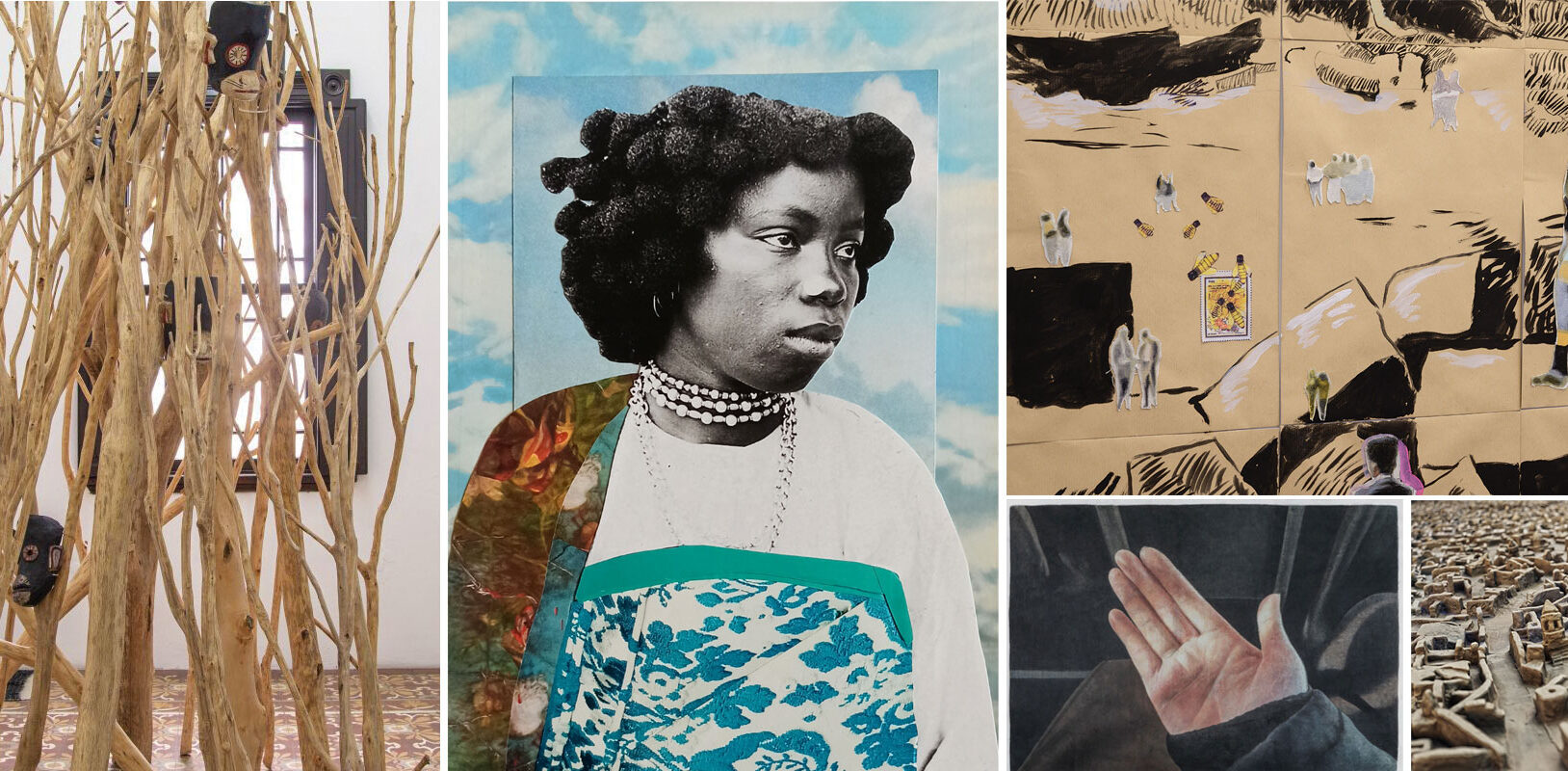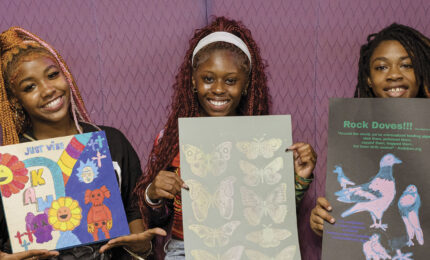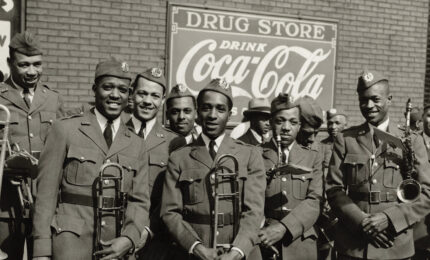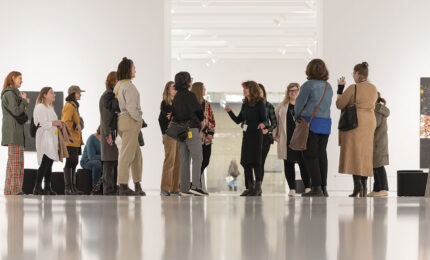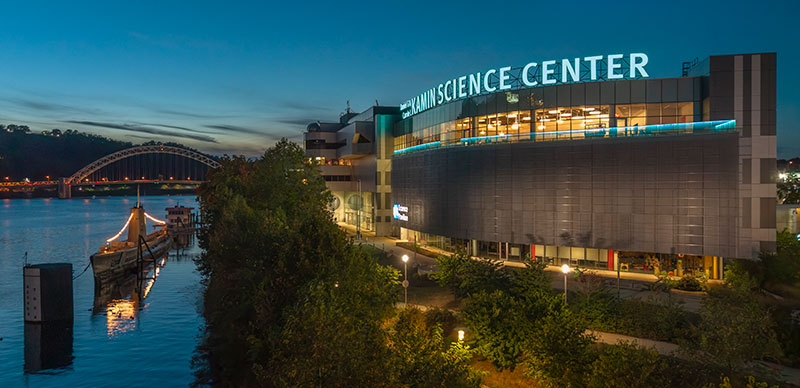Is it morning for you yet?
It could just be an odd kind of Good-Morning greeting: Has your day begun? Shrugged off the cobwebs? First cup of coffee? But when posed by the artist Édgar Calel, who is of Mayan descent, to the curators of the upcoming 58th Carnegie International, this question became about far more than waking up. It was about recognizing the differences in our worldviews. Or, to use a word that crops up time and again regarding the more than 150 artists and other participants in this year’s Carnegie International, the differences in our cosmologies—the parallel contexts with which we understand the world. It’s as if to say, in the world you inhabit, what is the truth?
And so it was that the 58th Carnegie International would borrow the Mayan Kaqchikel expression “Is it morning for you yet?” as its title. For Sohrab Mohebbi, the Kathe and Jim Patrinos Curator of the 58th Carnegie International, it reinforced a meaning of the word “international” as not just about bringing a broad range of nationalities to Pittsburgh but an array of perspectives as well.
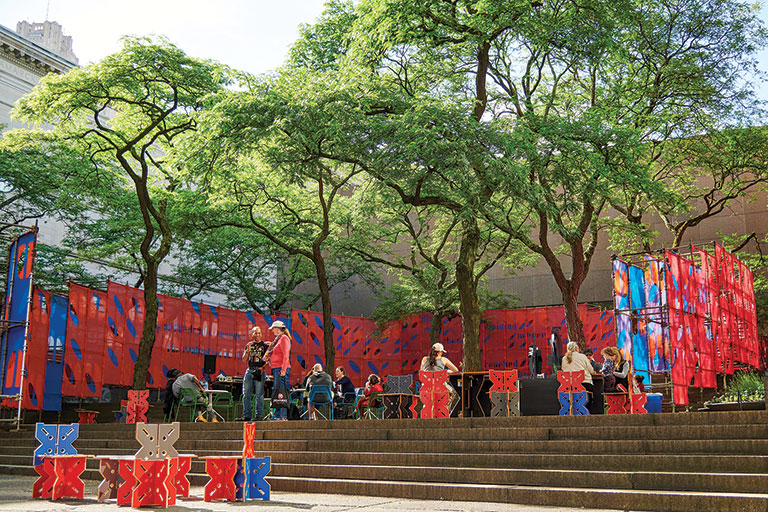
Installation view of Rafael Domenech, Dividing an edge from an ever (pavilion for Sarduy) at Carnegie Museum of Art, 2022
“I really like that word ‘perspective,’” says Mohebbi, “because that’s the challenge of how to make international shows work—how can you actually try to introduce different perspectives? It’s easy to talk about it, but you can end up putting yourself in; speaking, looking, seeing on behalf of others. So, we tried to account for many different points of view, and to let things follow the lead of the artwork.”
An artist such as Calel is a good example. A member of the Kaqchikel, an Indigenous Mayan people of present-day Guatemala, his work explores his culture’s understanding of memory, spirituality, and language through artworks stemming from ritual and tradition. That exploration takes the form of performance, installation, drawing—many media, one mission.
“Each artist through their work invites us to see their history, their roots, and their vision of the world,” says Calel. “I feel honored to share, through art, a part of that millenary heritage that our grandmothers and grandfathers left sown in our memory and in the Indigenous Maya Kaqchikel territory.”
Sown in our memory. It’s a phrase that could be used by many of the artists in this International because they tell stories of personal histories, and art histories, that in many cases exist not within but parallel to the dominant narrative we’re told; they have battled simply to exist. In the 58th Carnegie International, Is it morning for you yet?, these artworks join together to ask seismic questions, not just of history or art but also of the way we understand being in the world. And they ask not just that we glimpse another’s artwork but also another’s cosmology.
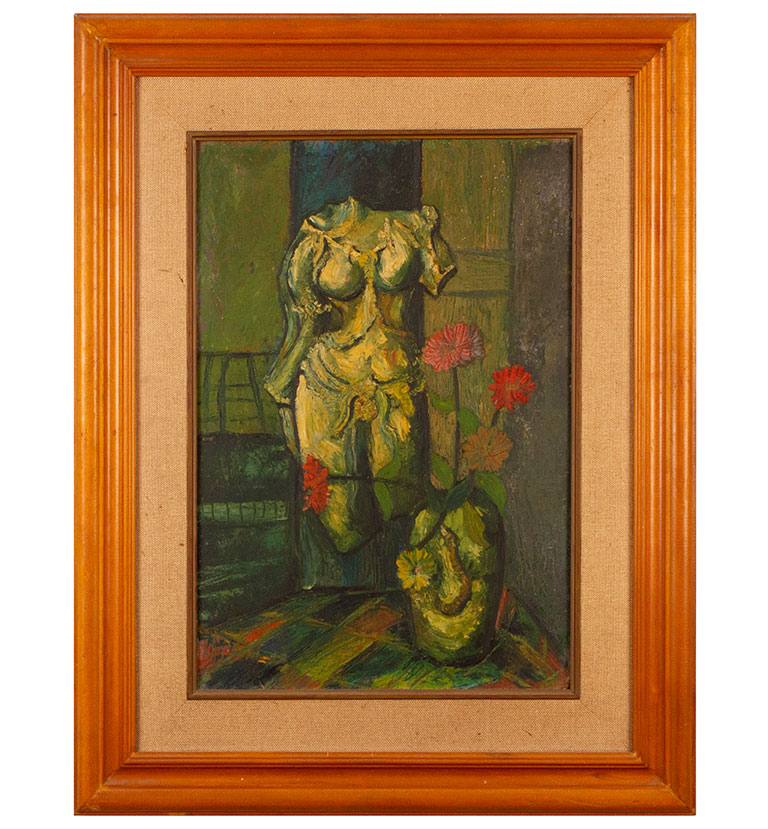
Griya Seni Hj. Kustiyah Edhi Sunarso, Torso, 1960
Balancing Global and Local
For more than 125 years, the Carnegie International has been a signal event for the art world. Mohebbi, associate curator Ryan Inouye, and curatorial assistant Talia Heiman—plus a large team of advisers and associates—are the latest to attempt the International’s great balancing act: to be meaningful to both the global art community and to the people of Pittsburgh.
The International’s 21st-century editions have been a process of finding the right fit. For some years, like in 2004, the International has leaned towards bringing the big names of the art world to Pittsburgh—like Jeremy Deller, Maurizio Cattelan, and Francis Alÿs. The 2013 Carnegie International pivoted toward a concept—about the politics of “play”—which allowed for a bigger influx of emerging names and odd juxtapositions. Assembled for the first time by a team, it extended its reach beyond the museum, with aspects of its work moving into other Pittsburgh neighborhoods.
“Each artist through their work invites us to see their history, their roots, and their vision of the world.” – artist Édgar Calel
The 2022 exhibition, which runs at Carnegie Museum of Art from Sept. 24 to April 2, 2023, is a show strongly rooted in concept, which subtly reveals another world to its audiences—a world that has existed beside us for decades, if often hidden or obscured by history.
As in the past, the 58th Carnegie International will showcase the work of many young and emerging artists, such as Aziz Hazara, Dala Nasser, and Ali Eyal. But by including artists both established and lesser known from previous generations—both through their own work, and as collected by institutions, estates, and fellow artists—this exhibition also stretches back to include works created through much of the International’s history, starting with 1945, the beginning of both American geopolitical dominance and, some would say, contemporary art. The question is, whose idea of contemporary art begins there? And what other aesthetics and worldviews survived in parallel through it all?
Colonialism and Revolution
In 1950s and ’60s Indonesia, the painter Kustiyah made images of everyday life dramatized with rough lines and dark, earthy, yet pulsating colors. She was painting a revolution—Indonesian independence—and she was of the people. In fact, she was part of a group of artists known as the Pelukis Rakyat, the “People’s Painters.” But despite living well into the 21st century, today she is little known, even in her own nation.
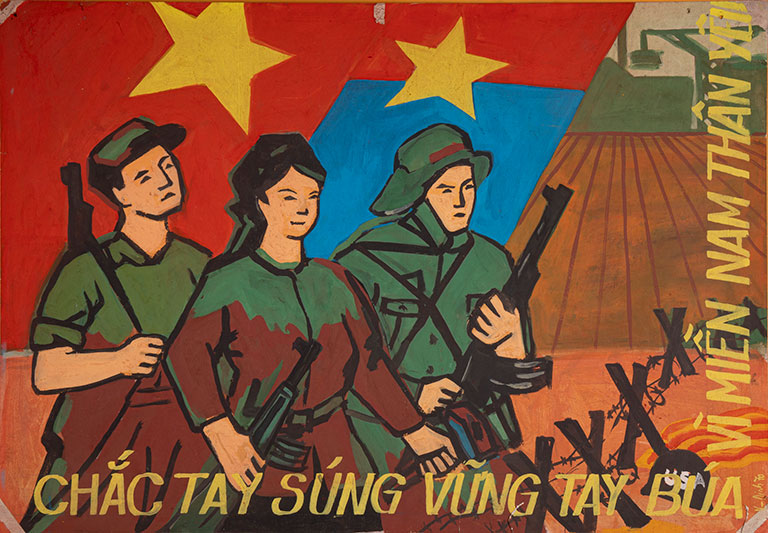
Dogma Collection, Untitled propaganda poster (A-side), ca. 1965-75, The Private Dogma Collection (English translation: Clasp the gun with faith, for our beloved South)

Dogma Collection, Untitled propaganda poster (B-side), ca. 1965-75, The Private Dogma Collection
Hyphen, a group of young Indonesian artists, curators, and historians that came together in 2011, is trying to change that with their collection As If There Is No Sun—which will be shown as part of the 58th Carnegie International. Its title is taken from a 1957 critique of the Pelukis Rakyat’s work.
“The full sentence [of the critique] was, ‘The paintings exhibited here made it feel as if there is no sun in Indonesia,’” says Grace Samboh, one of the founders of Hyphen. “Indeed, a certain kind of darkness, cloud, or even eeriness are vivid in the so-called ‘revolutionary painters’ generation; as if to paint the ray of sun and its warmth would exoticize their subject matter, the common people—[which is] what they were fighting against with the colonial painters.”
As Kustiyah and the other like-minded artists in As If There Is No Sun were emerging from revolutionary Indonesia, artists in their Southeast Asia neighbor, Vietnam, were entering into a similarly dangerous period. Võ An Khánh is an octogenarian photographer who worked for the Northern Vietnamese Communist Army’s Office of Entertainment in the 1960s and ‘70s, following guerrilla forces through combat. Without access to high-speed film, Khánh took to restaging moments he saw in action, resulting in fantastically eerie, yet enduringly human images of war from a vantage not frequently seen in America.
Other work from wartime Vietnam is included in the 58th Carnegie International as well. Works saved by the Dogma Collection include Vietnamese propaganda posters full of soldiers and guns, repurposed by artists in the same period. With a paper shortage, visual artists used the backs of these posters for their classroom life-drawing exercises, resulting in supple, tender nude figures drawn on the flipside of the harsher wartime propaganda images. Thanks to Dogma Collection, these anonymous artists’ drawings survive—hidden, literally—behind the images of war.
“So what you get is, on one side, the body in service of ideology, and on the other side, the body free from that and in the service of the imagination of the artist,” Mohebbi explains. “That was what was particularly interesting for us; in fact, it almost defined us.”
Human, aesthetic responses that exist beside, not simply within, the ongoing war effort helped define another question for Mohebbi: How to make an exhibition that follows America and the West’s global impact of the past 80 years, but that isn’t only about that?
“How can we make it so that it’s not always about artwork in conversation with that American center?” Mohebbi says. “We wanted to acknowledge that, in all of these places impacted by U.S. geopolitical decisions, there have been aesthetic traditions and artistic practices that resist, and survive, and continue.”
Liberating Art from Museums
A number of focus areas become apparent when looking over the vast array of artists involved in this year’s International, including geographic locations and, importantly, existing artists’ collections.
Central and South America are well represented, with contributions such as those from the Museo de la Solidaridad Salvador Allende—a Chilean collection of artist-donated works kept secret during President Augusto Pinochet’s 1970s regime—and from Mexico City’s 1980s revolutionary art and poetry group Colectivo 3, among many others.
There are historical collections and documentation of work from Southeast Asia and sub-Saharan Africa that have rarely been seen in America, and the well-known Iranian artist Fereydoun Ave contributes work from his vast personal collection. Meanwhile, young Iraqi artists such as Ali Eyal and Mohammed Sami provide a new vision of themselves and their region.
The exhibition’s American contributors come largely from situations not too dissimilar from their far-flung colleagues: communities that, through prejudice, poverty, and, particularly for America, a history of incarceration, have been left out of the national narrative.
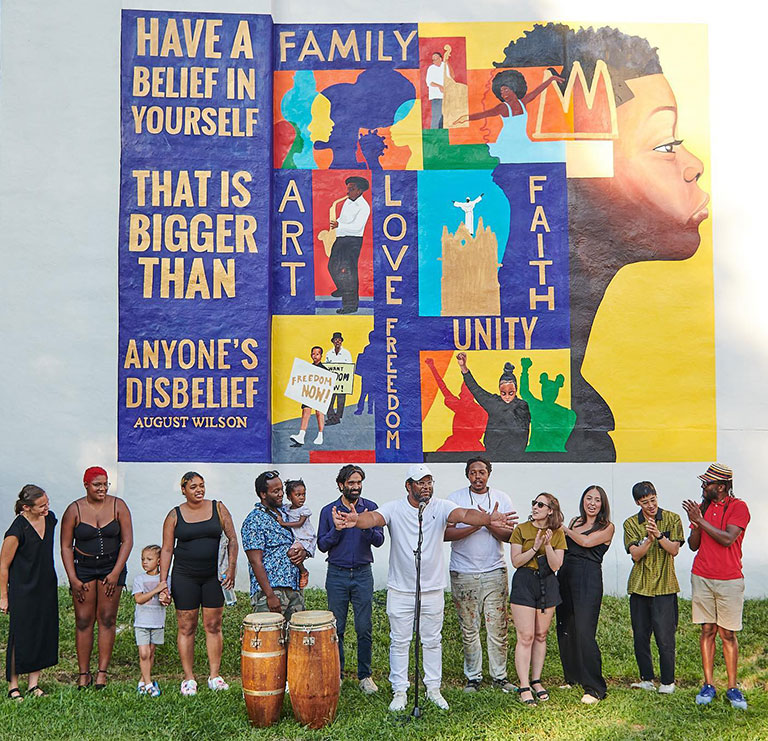
James “Yaya” Hough, a Gift to the Hill District, 2021-2022
James “Yaya” Hough is a Pittsburgh-born artist who, after being convicted of murder at the age of 17, began making drawings and large-scale mural art while serving a life-without-parole sentence in prison. Thanks to a redemptive change in law regarding such sentences for minors, Hough earned his release in 2019 after having served 27 years. He was immediately named the inaugural artist-in-residence for the district attorney’s office in Philadelphia, and in 2020 had his first museum exhibition in New York City. For the 58th Carnegie International, Hough worked with the community he was brought up in to make a mural on the side of a Hill District home: A Gift to the Hill District. The mural on Centre Avenue was unveiled during a community celebration on July 30.
“I was very specific about wanting to do something outside the museum, and to do something in the community,” says Hough. “Public art is about how communities see themselves—it’s an important and powerful tool that we as human beings have to broadcast messages; a barometer of not just how we see ourselves, but how we aspire to see ourselves.”
The history of the Hill District is well known to longtime Pittsburghers. It was a thriving Black community, nationally known for its outsized contribution to music, art, and literature, bisected by development and left to fade from glory. Hough’s mural—full of colors, images, and texts chosen (and painted) by the community—is meant to inspire people to aim high. It is dominated by a text from the great Hill District playwright August Wilson: “Have a belief in yourself that is bigger than anyone’s disbelief.”
“I walk to the installation site and I’m walking in the footsteps of giants,” says Hough. “Billy Strayhorn, Gus Greenlee, August Wilson, all these people who left their mark. Knowing that I’m traveling in the pathways of those people, as well as the everyday folk that August Wilson wrote about—it’s great company. I’m extremely happy to be here.”
“Public art is about how communities see themselves—it’s an important and powerful tool that we as human beings have to broadcast messages; a barometer of not just how we see ourselves, but how we aspire to see ourselves.” -James “Yaya” Hough, Pittsburgh-born artist
Hough has an extra connection with the Carnegie Museum of Art: As a teenager, he attended Saturday art classes at the museum, so he sees his participation in the International as coming “full circle.” But he was adamant that his work be outside, where those not visiting the exhibition could experience it, and where it could thrive in a place of freedom.
“There’s a great power in liberating art from museums and institutions,” says Hough. “There’s a power in people having an engagement in art in their everyday life. It breeds conversation, community, and engagement on a personal level. To me, while that can happen in museums and galleries, it doesn’t happen as much.
“The world is much larger outside than inside. That part of it, I’m very familiar with.”
Translating Culture
The cosmology of Édgar Calel’s culture survived a long period of colonization, in part because of its destruction. One aspect of the artist’s International work is a set of drawings made of shards of pottery found by his father. It is the shattered remnants of the Kaqchikel’s material culture—destroyed so that it couldn’t be co-opted, instead surviving through stories, ideas, and a way of being. His work, like so many in the 58th Carnegie International, is a kind of ritual act of translation.
“Beyond translating culture and rituals, I think that I am—and we [artists] are—translating life and culture,” says Calel. “We do it through objects, drawings, words, gestures, thoughts that affirm our presence today.”
“One of the key words for the International was ‘reconstitution,’” says Mohebbi. “How our aesthetic practices—not just of art, but the aesthetics of the everyday; of how to live a beautiful life—how did these practices continue to survive alongside decades of human-caused disruption?”
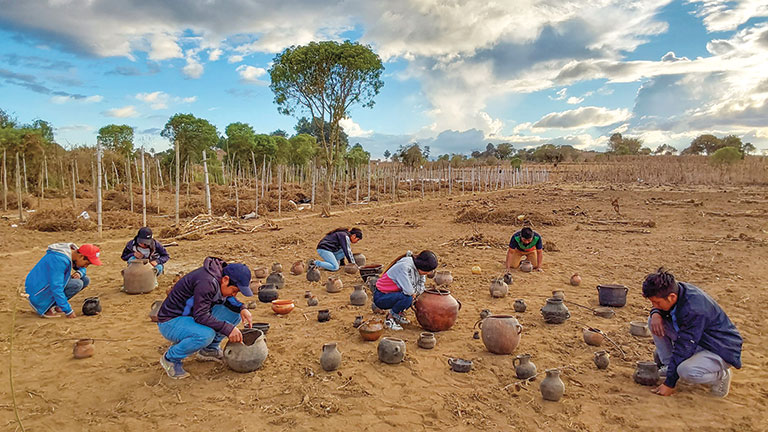
The family of Edgar Calel performing the Oyonik healing ritual in the fields of San Juan Comalapa; image courtesy of Proyectos Ultravioleta and the artist
Mohebbi is quick to point out that Pittsburgh’s turbulent 20th-century history follows the same era as that covered in this exhibition: from helping build the modern world, to the crisis of the steel crash, to renaissance after renaissance, and, for some local communities, disappointment after disappointment.
It’s a lot to ask of an art show. But perhaps this vast exhibition, with so many artists and cosmologies represented, is itself an act of reconstitution—of giving to Pittsburgh a way of coming out from the madness of the 2020s thus far with a subtly different vision of how we might be.
To find out whether or not it is, in fact, morning for us yet.
Sponsors:
The 58th Carnegie International, presented by Bank of America, is made possible by leadership support from Kathe and Jim Patrinos.
Major support is provided by the Carnegie International Endowment, The Fine Foundation, the Jill and Peter Kraus Endowment for Contemporary Art, and the Carnegie Luminaries.
Significant support is provided by Teiger Foundation, The Andy Warhol Foundation for the Visual Arts, The Susan J. and Martin G. McGuinn Exhibition Fund, Henry L. Hillman Foundation, and the Keystone Members of the Carnegie International. The 58th Carnegie International has been made possible in part by the National Endowment for the Humanities.
Generous support is provided by the Heinz Family Foundation, E. Rhodes and Leona B. Carpenter Foundation, The Heinz Endowments, Nemacolin, the Louisa S. Rosenthal Family Fund, and the Friends of the Carnegie International. This project is supported in part by the National Endowment for the Arts.
Additional support is provided by the Mondriaan Fund, the Akers Gerber Foundation, Carnegie Mellon University, Buchanan Ingersoll and Rooney, Highmark Blue Cross Blue Shield and Allegheny Health Network, NOVA Chemicals, Sotheby’s, Orange Barrel Media, Fort Pitt Capital, the Henry Moore Foundation, Advance Auto Parts, Christie’s, Giant Eagle Foundation, UPMC and UPMC Health Plan, the Japan Foundation, PJ Dick-Trumbull-Lindy Group, the Fans of the Carnegie International, and the Carnegie Collective.
The 58th Carnegie International is supported as part of the Dutch Culture USA program by the Consulate General of the Netherlands in New York, and is supported by Etant donnés Contemporary Art, a program from Villa Albertine and FACE Foundation, in partnership with the French Embassy of the United States.
Support for the exhibition catalogue is provided by Gladstone Gallery, Antenna Space Shanghai, De Buck Gallery, Experimenter, Gajah Gallery, Greene Naftali, Hannah Hoffman Gallery, JTT New York NY, Luhring Augustine, Michael Werner Gallery, Modern Art, Proyectos Ultravioleta, Rodeo London / Piraeus, Rossi & Rossi (Hong Kong) Limited, Salon 94, and Stephen Friedman Gallery.
Carnegie Museum of Art is supported by The Heinz Endowments and Allegheny Regional Asset District. Carnegie Museum of Art receives state arts funding support through a grant from the Pennsylvania Council on the Arts, a state agency funded by the Commonwealth of Pennsylvania.
